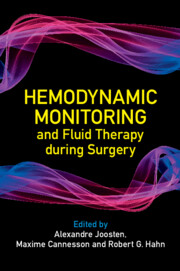Book contents
- Frontmatter
- Contents
- List of Contributors
- Foreword by Jean-Louis Vincent
- Preface
- Section 1 Hemodynamic Monitoring in the Perioperative Period
- Section 2 Basic Science & Concepts in Fluid Therapy
- Section 3 Practical Use
- Section 4 Future Directions
- 22 Optimizing Hemodynamic Therapy by Monitoring Microcirculation: One Step Forward in Matching Tissue Oxygen Delivery to Consumption
- 23 Predictive Analytics and Artificial Intelligence
- 24 Clinical Decision Support and Closed-Loop Systems for Goal-Directed Hemodynamic Therapy
- 25 Postoperative Surveillance: The Rise of Wireless Sensors, Pocket Ultrasound Devices and AI-Enabled Tools
- 26 Can Perfusion Index Be Useful for Fluid and Hemodynamic Management?
- Index
22 - Optimizing Hemodynamic Therapy by Monitoring Microcirculation: One Step Forward in Matching Tissue Oxygen Delivery to Consumption
from Section 4 - Future Directions
Published online by Cambridge University Press: 11 April 2024
- Frontmatter
- Contents
- List of Contributors
- Foreword by Jean-Louis Vincent
- Preface
- Section 1 Hemodynamic Monitoring in the Perioperative Period
- Section 2 Basic Science & Concepts in Fluid Therapy
- Section 3 Practical Use
- Section 4 Future Directions
- 22 Optimizing Hemodynamic Therapy by Monitoring Microcirculation: One Step Forward in Matching Tissue Oxygen Delivery to Consumption
- 23 Predictive Analytics and Artificial Intelligence
- 24 Clinical Decision Support and Closed-Loop Systems for Goal-Directed Hemodynamic Therapy
- 25 Postoperative Surveillance: The Rise of Wireless Sensors, Pocket Ultrasound Devices and AI-Enabled Tools
- 26 Can Perfusion Index Be Useful for Fluid and Hemodynamic Management?
- Index
Summary
Restoring the microcirculation and tissue oxygenation is the ultimate goal of hemodynamic resuscitation. Hand-held vital microscopes enable direct visualization of the sublingual microcirculation of RBC flow through the capillaries and the density of perfused capillaries. The association between alterations of sublingual microvascular parameters and patient outcomes during shock validates that these parameters are clinically relevant for the assessment of patients in shock. Assessment of sublingual microvascular perfusion parameters at the bedside is only conceivable if hand-held vital microscopes are easy to use and if the analysis of the images can be done in real time. Studies have shown that real-time point-of-care assessment by visual inspection of microcirculatory properties at the bedside shows good agreement with off-line evaluation of the microcirculation. The development of automatic microcirculatory analysis software systems will be the next step to obtain high-performance quantitative analysis at the patient’s bedside and for caregivers to adhere to this monitoring technique. Lastly, the impact of sublingual microcirculation on patient outcome remains to be proven during the perioperative setting.
Keywords
Information
- Type
- Chapter
- Information
- Hemodynamic Monitoring and Fluid Therapy during Surgery , pp. 257 - 266Publisher: Cambridge University PressPrint publication year: 2024
